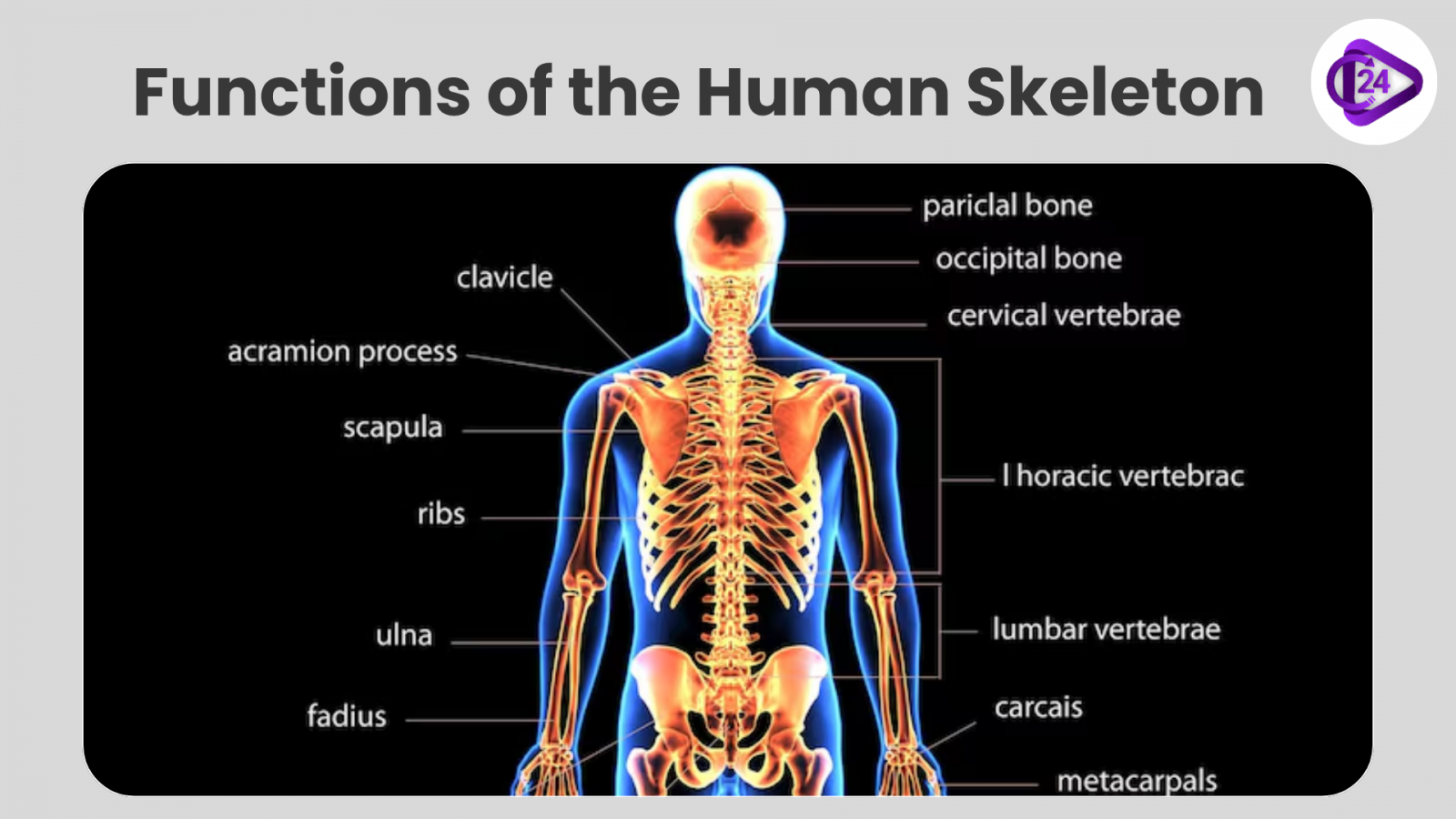The Human Skeleton: Structure, Function, and Importance, Bone Disorders

The human skeleton is a very outstanding and intricate structure of bones and joints that forms the structure of the body. It does not only help to support our physical organism, but also plays numerous important roles that cannot be overlooked by the process of survival. we shall discuss the structure, functions, formation and significance of human skeleton and the significance of the same in human health.
Introduction to the Human Skeleton
The skeleton of human beings consists of 206 bones, and they differ in size and shape and are categorized into two major skeletons: axial skeleton and appendicular skeleton. These bones, together with cartilage, ligaments and tendons, combine to enable movement, protect internal organs, store minerals and generate blood cells. Science of bones is referred to as osteology and it offers essential information on not only the biological aspect of human beings but also on evolution.
Composition of the Human Skeleton
1. Bone Tissue
Bones are primarily composed of two types of tissues:
- Cortical (Compact) Bone: This is the dense, outer layer of bone that provides strength and rigidity.
- Trabecular (Spongy) Bone: Found mostly at the ends of long bones and inside others, this tissue has a porous structure and helps absorb shock and reduce weight.
Bones also contain bone marrow, where blood cells are produced. The marrow is found in the central cavities of certain bones, such as the femur and sternum.
2. Cartilage
Cartilage is a flexible, semi-rigid tissue found in joints, the ribs, the nose, ears, and parts of the respiratory system. It provides cushioning and support, reduces friction between bones, and helps in growth and development.
3. Ligaments and Tendons
- Ligaments: These are tough, elastic tissues that connect bones to other bones at joints. They provide stability and help limit excessive movement.
- Tendons: Tendons are connective tissues that attach muscles to bones, enabling movement when muscles contract.
Types of Bones in the Human Skeleton
Human bones come in various shapes and sizes, and they are classified into four main categories:
- Long Bones: The long bones, longer than they are wide, include the femur (the longest bone in the body) as well as relatively small bones in the fingers. Long bones function to support the weight of the body and facilitate movement. Long bones are mostly located in the appendicular skeleton and include bones in the lower limbs (the tibia, fibula, femur, metatarsals, and phalanges) and bones in the upper limbs (the humerus, radius, ulna, metacarpals, and phalanges).
- Short Bones: Short Bones: Short bones are not long, but about the same length as they are wide. Short bones are located in the wrist, as well as the ankle and serve to offer some stabilization and a bit of movement. Examples of short bones are the tarsals of the ankles ( calcaneus, talus, navicular, cuboid, lateral cuneiform, intermediate cuneiform and medial cuneiform) and the carpals of the wrist (scaphoid, lunate, triquetral, hamate, pisiform, capitate, trapezoid and trapezium).
- Flat Bones: There are flat bones in the skull (occipital, parietal, frontal, nasal, lacrimal, and vomer), the thoracic cage (sternum and ribs), and the pelvis (ilium, ischium, and pubis). The function of flat bones is to protect internal organs such as the brain, heart, and pelvic organs. Flat bones are somewhat flattened and can provide protection, like a shield; flat bones can also provide large areas of attachment for muscles.
- Irregular Bones: Irregular bones vary in shape and structure and therefore do not fit into any other category (flat, short, long, or sesamoid). They often have a fairly complex shape, which helps protect internal organs. For example, the vertebrae, irregular bones of the vertebral column, protect the spinal cord. The irregular bones of the pelvis (pubis, ilium, and ischium) protect organs in the pelvic cavity.
The Axial Skeleton

The skeleton is the core of the body and includes 80 bones that make the axial. It consists of the skull, vertebral column (spinal column) and rib cage. Here’s a closer look:
1. Skull
The skull of a human being consists of 22 bones, which are classified into two major components (cranial bones and facial bones): the skull protects brain and the face comprises of facial bones. The breakdown of the skull bones and their numbers is as following:
Cranial Bones (8 Bones)
These are the bones that shape the skull that covers the brain.
1. Frontal Bone (1 bone)
- Molds the forehead and the upper section of the eye sockets.
2. Parietal Bones (2 bones)
- The sides and the roof of the cranium are made of paired bones.
3. Temporal Bones (2 bones)
- Bones on the sides of the skull, directly under the parietal bones; these are the hearing and balance structures.
4. Occipital Bone (1 bone)
- Bears the rear and bottom of the head, cushions the brainstem.
5. Sphenoid Bone (1 bone)
- A bone in the base of the head in the form of a butterfly, which is a part of the eye sockets.
6.Ethmoid Bone (1 bone)
- The spongy, light bone which constitutes the eye sockets and the nose hole.
Facial Bones (14 Bones)
These are the bones that constitute the structure of the face which comprises the mouth, nose and the eyes.
1. Nasal Bones (2 bones)
- The bridge of the nose is made of the paired bones.
2. Maxillae (2 bones)
- The upper jaw, the hard palate, and some of the floor of the eye sockets have bones that are attached in pairs.
3. Zygomatic Bones (2 bones)
- Paired bones make the cheeks and a section of the outer eye socket.
4. Palatine Bones (2 bones)
- Bones that occur in pairs, are located on the back of the roof of the mouth and on the floor of the nasal cavity.
5. Lacrimal Bones (2 bones)
- Bones that are paired and made up of the medial wall of the eye socket.
6. Poor Quality of Nasal Conchae (2 bones)
- Bones located in the nose which are paired and serve to filter and humidify the air.
7.Vomer (1 bone)
- This is a single bone that makes up the lower end of the nasal septum.
8. Mandible (1 bone)
- The most powerful and the largest bone of the face is the lower jawbone. It carries the lower teeth and gives the capacity to move them in order to chew.
Skull Bones: 22 Bones
- Cranial Bones: 8
- Facial Bones: 14
These 22 bones combine to create the skull, which acts as a protection to the brain, offers support to the sensory organs, and forms the face.
2. Vertebral Column (Spine)
The spine has 33 vertebrae and forms the weight of the body as well as safeguarding the spinal cord. It is subdivided into five areas:
- Cervical Spine (Neck): 7 vertebrae.
- Thoracic Spine (Mid-back): There are 12 vertebrae.
- Lumbar Spin (Lower back): 5 spines.
- Sacrum: 5 fused vertebrae.
- Coccyx: 4 welded vertebrae (tailbone).
3. Rib Cage
There are 12 pairs of ribs, thoracic vertebrae, the rib cage, and the sternum (breastbone). It safeguards the important organs like the heart and lungs, also helps in breathing by expanding and contracting with the breathing movements.
The Appendicular Skeleton
The appendicular skeleton consists of 126 bones and is involved in movement. It includes the limbs (arms and legs) and the girdles (shoulder girdle and pelvic girdle) that attach them to the axial skeleton.
1. Upper Limbs
The upper limbs consist of the following bones:
- Clavicle (Collarbone): Connects the arm to the body.
- Scapula (Shoulder Blade): Provides attachment for muscles and supports the arm.
- Humerus: The upper arm bone.
- Radius and Ulna: The two bones of the forearm.
- Carpals, Metacarpals, and Phalanges: Bones of the wrist, hand, and fingers.
2. Lower Limbs
The lower limbs are designed for weight-bearing and locomotion:
- Pelvic Girdle: Composed of the ilium, ischium, and pubis, it connects the legs to the trunk and protects reproductive organs.
- Femur: The longest and strongest bone in the body.
- Patella (Knee Cap): Protects the knee joint and improves the leverage of the thigh muscles.
- Tibia and Fibula: The bones of the lower leg, with the tibia being the weight-bearing bone.
- Tarsals, Metatarsals, and Phalanges: Bones of the ankle, foot, and toes.
Functions of the Human Skeleton

The human skeleton is not just a static frame for the body; it serves many crucial functions:
1. Support
The skeleton provides the body with structure, supporting the weight of the body and giving shape to our appearance.
2. Protection
The bones protect vital organs. The skull protects the brain, the rib cage protects the heart and lungs, and the vertebrae protect the spinal cord.
3. Movement
Bones, along with muscles and joints, enable movement. Muscles contract to pull on bones, allowing us to walk, run, and perform various physical tasks.
4. Mineral Storage
Bones serve as a storage reservoir for minerals, particularly calcium and phosphorus. These minerals can be released into the bloodstream when needed to maintain mineral balance in the body.
5. Blood Cell Production
Bone marrow, found inside the cavities of certain bones, produces red blood cells, white blood cells, and platelets. This process is known as hematopoiesis.
6. Endocrine Regulation
Bones secrete hormones that help regulate blood sugar and fat metabolism. One such hormone is osteocalcin, which plays a role in the regulation of insulin and fat storage.
Bone Development and Growth
The process of bone formation is known as ossification, which begins in the fetus and continues into adulthood. There are two main types of ossification:
- Intramembranous Ossification: Bone forms directly from connective tissue. This type occurs in the flat bones of the skull.
- Endochondral Ossification: Bone replaces hyaline cartilage and is responsible for the formation of most bones in the body, including long bones like the femur.
During childhood and adolescence, bones grow longer and wider. The growth plates (epiphyseal plates) at the ends of long bones gradually ossify as a person reaches adulthood, signaling the end of growth.
Common Bone Disorders
Bone health is crucial to overall well-being, and several conditions can affect the skeleton. Some of the most common bone disorders include:
1. Osteoporosis
A condition where bones become weak and brittle, often due to a loss of bone density. It is common in older adults and can lead to fractures, particularly in the hips, spine, and wrists.
2. Arthritis
Arthritis refers to inflammation of the joints, leading to pain, stiffness, and reduced mobility. Osteoarthritis and rheumatoid arthritis are the most common forms.
3. Scoliosis
A condition in which the spine curves abnormally, leading to an “S” or “C” shape. It can cause pain and, in severe cases, affect organ function.
4. Osteogenesis Imperfecta
A genetic disorder that causes brittle bones, leading to frequent fractures and bone deformities.
5. Paget’s Disease
A chronic bone disorder where bones become enlarged and misshapen due to abnormal bone remodeling. It can lead to bone pain, fractures, and arthritis.
Conclusion
The human skeleton is not merely a frame of reference, but one that has important functions in movement, protection and overall well being. It is an amazing system with more than 200 bones which give us stability, flexibility and strength in our bodies. To appreciate the complexity of the human body and to keep the bones healthy at all times, it is important to understand the skeleton composition, functions, as well as the common disorders associated with the body. Since growth and development to effects of certain diseases such as osteoporosis, the role of the skeleton is fundamental in the operations of human body. Diet and exercise are also required to take proper care of the body by ensuring that the bones are strong and healthier with age.




